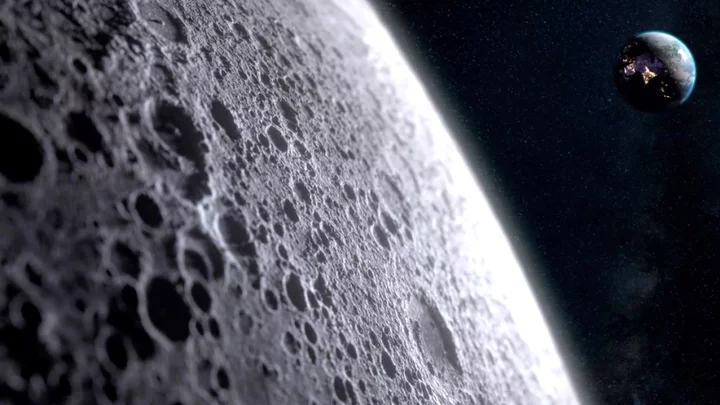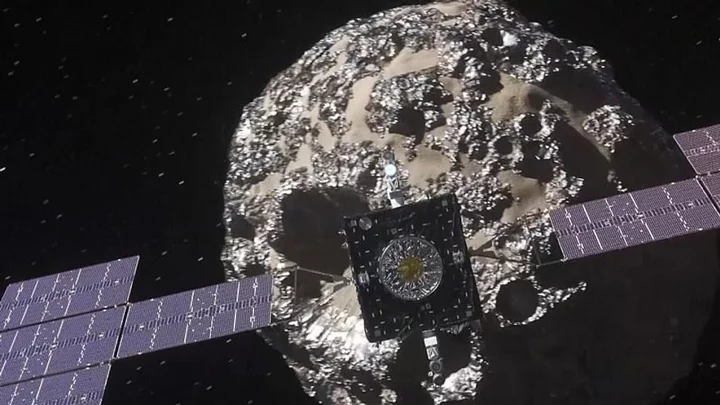
Microsoft buys Call of Duty developer in biggest deal in gaming history
Microsoft has completed its deal to buy Call of Duty developer Activision Blizzard in the biggest deal in gaming history. The $68.7 billion acquisition means the Xbox maker now owns games such as World of Warcraft and Diablo, as well as the Call of Duty series. Microsoft first announced the deal at the start of 2022. Since then it has faced intense scrutiny from regulators around the world – but the final of those investigations, from the UK’s Competition and Markets Authority, closed earlier on Friday. The process has forced Microsoft to make public commitments that its games will still be available on other platforms, such as PlayStation and the Nintendo Switch. “As one team, we’ll learn, innovate, and continue to deliver on our promise to bring the joy and community of gaming to more people,” said Xbox boss Phil Spencer. “We’ll do this in a culture that strives to empower everyone to do their best work, where all people are welcome, and is centered on our ongoing commitment of Gaming for Everyone. “We are intentional about inclusion in everything we do at Xbox – from our team to the products we make and the stories we tell, to the way our players interact and engage as a wider gaming community.” Microsoft has said that the deal will bring Activision’s games alongside its first-party offerings, including adding its titles to Xbox’s Game Pass subscription service. “Together, we’ll create new worlds and stories, bring your favourite games to more places so more players can join in, and we’ll engage with and delight players in new, innovative ways in the places they love to play including mobile, cloud streaming and more,” Mr Spencer said in the announcement. Read More Microsoft gets go-ahead to buy Call of Duty maker Activision Google is about to ditch passwords forever EU to investigate X’s handling of disinformation over Hamas attack on Israel
2023-10-13 21:29

Takashi Tezuka reveals the secrets to Mario's success
Takashi Tezuka has revealed what has helped 'Mario' to become a legendary gaming franchise.
2023-10-13 21:24

Activision bid receives UK regulatory approval
Microsoft's acquisition of Activision Blizzard has been approved by the UK regulator.
2023-10-13 21:23

When Did Vampires and Werewolves Start Hating Each Other?
Their (often literal) blood feud is a relatively modern creation. So how did vampires and werewolves end up at each other’s throats?
2023-10-13 21:18

Low-flying helicopter sparks crazy crocodile orgy in Australia
Hundreds of crocodiles in Australia were recently sent into a sex frenzy when a low-flying Chinook helicopter passed overhead. Ranchers from the Koorana Crocodile Farm in Queensland, which houses more than 3,000 crocodiles, said many of their residents became aroused after the flyby. John Lever, owner of the farm, said pilots use it as a marker point in their flights. When a pilot flew low so their passengers could take a picture of the crocodiles, the reptiles were whipped up into a frenzy. He said: “All of the big males got up and roared and bellowed up at the sky, and then after the helicopters left they mated like mad. “There's something about the sonic waves that really gets them stirred up.” As it turns out, thunderstorms regularly act as an aphrodisiac to crocodiles. If the reptiles mate during storm season, their babies are more likely to hatch in a non-thunderstorm season, meaning they don’t drown in flood water. “The crocodiles start vocalising to each other [when a storm is coming],” Lever said. “They don't have a very sophisticated voice box, but they vibrate their windpipes to send messages through the water.” That may explain why the helicopter caused such an aroused response – they thought it was a megastorm. Herpetologist Mark O'Shea from the University of Wolverhampton told LiveScience: “Chinooks may artificially recreate the sound of the start of a thunderstorm.” Another possible explanation is that the movements in the water or downward wind caused by the choppers could trick them into thinking there is a change of atmospheric pressure, like when a storm is approaching. “I imagine that the downdraft from a large, heavy helicopter would create a change in pressure that the [sensory organs] on crocodile skin can detect. “Dropping barometric pressure from a downdraft may resemble the change in pressure from a storm.” Sign up to our free Indy100 weekly newsletter Have your say in our news democracy. Click the upvote icon at the top of the page to help raise this article through the indy100 rankings.
2023-10-13 20:51

'All hands on deck.' How Israel's vital tech sector is navigating the war
Israel's vast tech sector has seen its fair share of crises, from financial downturns and the Covid-19 pandemic to periodic flare-ups in the Israeli-Palestinian conflict. Each time, the industry has bounced back, demonstrating why the country of just 9 million people is known as the world's "startup nation."
2023-10-13 20:46

Scientists could use lunar dust to make roads on the moon
Scientists have come up with a potential solution to deal with dust on the moon which makes conducting research tricky. Dust erodes space suits, clogs machinery, interferes with scientific instruments and makes moving around on the surface difficult. But they reckon moon dust could be melted using a giant lens developed by the European Space Agency to create solid roads and landing areas. Using a fine-grained material called EAC-1A, developed as a substitute for lunar soil, scientists used a 50mm diameter laser beam to heat the dust to about 1,600C and melt it. Then they traced out bendy triangle shapes, which could be interlocked to create solid surfaces across large areas of lunar soil to be used as road. However it would take about 100 days to create a 10 x 10m landing spot so it is not a quick fix. To make matters worse, the lens needed for the laser to work would be difficult to transport from Earth and could also get dust in it which may reduce its functionality. “You might think: ‘Streets on the moon, who needs that?’” said Prof Jens Günster, of the Federal Institute of Materials Research and Testing in Berlin and co-author of a report on the possible solution. “But in fact it’s a kind of depressing demand [even] early on. It’s very loose material, there’s no atmosphere, gravity is weak, so the dust gets everywhere. It contaminates not only your equipment but other nations’. No one would be happy to be covered in dust from another rocket." Dust has blighted previous missions, such as the Surveyor 3 spacecraft (damaged by dust kicked up by the Apollo 12 landing), and overcoming this challenge is a priority for Nasa, which aims to establish a permanent lunar outpost. Transporting building materials to the moon would be too expensive, so there is a need for unconventional solutions. “You need to use what’s there and that’s simply loose dust,” said Günster. The findings are published in the journal Scientific Reports. Sign up to our free Indy100 weekly newsletter Have your say in our news democracy. Click the upvote icon at the top of the page to help raise this article through the indy100 rankings.
2023-10-13 20:19

EU opens an investigation into Elon Musk's X over 'disinformation'
The EU has opened an investigation into Elon Musk's X over the possible spread of terrorist and violent content, and hate speech, after Hamas' attack on Israel. The EU's industry chief, Thierry Breton, confirmed on Thursday the bloc had sent Twitter/X a "formal request for information" to determine whether the platform was complying with the Digital Services Act (DSA) - a law designed to protect users of big tech platforms which came into effect November, as misinformation about the conflict between Israel and Hamas spreads on social media. In a statement on Thursday, the EU said “the European Commission services sent to X a formal request for information under the Digital Services Act (DSA)”. “This request follows indications received by the Commission services of the alleged spreading of illegal content and disinformation, in particular the spreading of terrorist and violent content and hate speech. The request addresses compliance with other provisions of the DSA as well.” In his letter to Musk, Breton said "violent and terrorist content" had not been taken down from X, despite warnings. Breton did not give details on the disinformation he was referring to in the letter, but said instances of "fake and manipulated images and facts" were widely reported on the social media platform. Responding on X, Musk said: "Our policy is that everything is open and transparent, an approach that I know the EU supports. "Please list the violations you allude to on X, so that the public can see them." X chief executive Linda Yaccarino also said earlier on Thursday the platform had removed hundreds of Hamas-affiliated accounts and taken action to remove or label tens of thousands of pieces of content since Saturday's attack. Sign up to our free Indy100 weekly newsletter Have your say in our news democracy. Click the upvote icon at the top of the page to help raise this article through the indy100 rankings.
2023-10-13 18:16

Nasa is looking for diamonds and precious stones on metal asteroid
Nasa is sending a rocket to a metallic asteroid between Mars and Jupiter in the hope of finding diamonds and rubies. The mission, which is set to launch on Friday 13 October, will involve visiting the mysterious metallic asteroid 16 Psyche, which sits in an asteroid belt between the two planets. The journey will take seven years for Falcon Heavy, a craft made by Elon Musk’s space exploration firm SpaceX. It was due to take off on Thursday, but the launch was postponed because of bad weather. Nasa Administrator Bill Nelson said: “We are launching a billion dollar spacecraft all the way beyond Mars and close to Jupiter and it’s going to snuggle up next to a metallic asteroid, and we are going to learn something about that metallic asteroid. “I hope we might find diamonds and rubies on that asteroid. “Everything is a new discovery, and we are glimpsing more of the development of this magnificent thing we call the universe.” Falcon Heavy takes off on its four-billion-mile journey at 10.19am in Florida, from the Kennedy Space Center. That is 3.16pm UK time. By May 2026, it will pass by Mars and use the planet’s gravitational force to slingshot itself toward the asteroid. Four years later, it will reach its destination. There, it will find a rock made up of iron and nickel, scientists believe. But they also think it could contain precious metals and gems. 16 Psyche has puzzled astronomers since it was discovered by Italian astronomer Annibale de Gasparis in 1852. In the 1980s, radar readings found that it was made of metal, leading scientists to speculate that the 130-mile boulder lost its outer shell by colliding with other asteroids. The spacecraft will spend about 26 months in orbit, taking images of the asteroid to get a clearer picture of its topography, surface features, gravity and magnetism. The asteroid will not be mined – but space agencies might just start taking more notice if they find its one massive diamond. Sign up to our free Indy100 weekly newsletter Have your say in our news democracy. Click the upvote icon at the top of the page to help raise this article through the indy100 rankings.
2023-10-13 18:15

Orsted Slumps as US Wind Cost Ruling Stokes Writedown Fear
Shares in Orsted A/S fell the most in more than a month after New York regulators ruled against
2023-10-13 17:49

UK removes final hurdle to Microsoft's blockbuster Activision Blizzard deal
UK antitrust officials have approved Microsoft's planned takeover of Activision Blizzard, the maker of "Call of Duty" and other hit games, greenlighting one of the biggest tech deals of all time.
2023-10-13 17:22

A scientist may have just proven that we all live inside a computer simulation
“The Matrix is everywhere. It is all around us. Even now in this very room." So says Laurence Fishburne’s Morpheus in sci-fi classic ‘The Matrix’ as he offers Keanu Reeves’s Neo the choice to find out just how “deep the rabbit hole goes”. Now, just as Neo discovered that the "life" he'd been living was little more than an algorithmic construct, scientists and philosophers are arguing that we could be stuck inside a simulation ourselves. In a paper published earlier this month, physicist Melvin Vopson, of the University of Portsmouth, offered scientific evidence for a philosophical theory known as the simulation hypothesis. This, in a nutshell, posits that the entire universe and our objective reality are just super-advanced virtual reality illusions. Elon Musk is among the well-known fans of the theory, which – as Dr Vopson notes in his paper – has been “gaining traction in scientific circles as well as in the entertainment industry”. The university lecturer also pointed out that recent developments in a branch of science known as information physics “appear to support this possibility”. Information physics suggests that physical reality is made up of bits of information. However, Dr Vopson has gone further and is working to prove that information has a physical mass and is a fundamental building block of the universe. He even claims that information could be the mysterious dark matter that makes up almost a third of the universe. In previous research, the physicist proposed that all elementary particles (the smallest known building blocks in the universe), store information about themselves, much like DNA in humans. Then, in 2022, he discovered a new law of physics, christened the second law of infodynamics, which states that entropy – the degree of randomness or disorder – within an isolated information system either remains constant or decreases over time. In other words, the system becomes less and less chaotic, implying that there is some kind of mechanism governing it rather than random chance. “I knew then that this revelation had far-reaching implications across various scientific disciplines,” Dr Vopson said in a statement released by the University of Portsmouth. “What I wanted to do next is put the law to the test and see if it could further support the simulation hypothesis by moving it on from the philosophical realm to mainstream science.” Is the Universe a Simulation? | Melvin Vopson www.youtube.com Dr Vopson employed the law in a range of different fields, including genetics, cosmology and even symmetry. Here, he found that the abundance of symmetry in the Universe (think snowflakes and facial structures) could be explained by the second law of infodynamics. "Symmetry principles play an important role with respect to the laws of nature, but until now there has been little explanation as to why that could be,” he said. “My findings demonstrate that high symmetry corresponds to the lowest information entropy state, potentially explaining nature's inclination towards it." Again, put simply, nature prefers things to be as well-ordered as possible. He continued: “This approach, where excess information is removed, resembles the process of a computer deleting or compressing waste code to save storage space and optimise power consumption.” As a result, this “supports the idea that we’re living in a simulation.” Dr Vopson is serious about this idea and, last year, even launched a crowdfunding campaign to test it. At the time, he announced that he had designed an experiment to determine whether we are all just characters in an advanced virtual world. “There is a growing community out there looking seriously at the possibility that information is more fundamental to everything than we think,” he said in a statement released back in December. “If information is a key component of everything in the universe, it would make sense that a vast computer somewhere is in control. “Assuming the universe is indeed a simulation, then it must contain a lot of information bits hidden everywhere around us. I’ve devised an experiment that proposes a way of extracting this information to prove it’s there.” His proposed experiment is based on his conclusion that information is physical and that elementary particles have a DNA of information about themselves. He posited that the information in an elementary particle could be detected and measured by using particle-antiparticle collision. “We can measure the information content of a particle by erasing it. If we delete the information from the particles, we can then look at what’s left,” he said in the December statement. “This experiment is highly achievable with our existing tools, and I’m hoping the crowdfunding site will help us achieve it.” And whilst the crowdfunder closed well before reaching its proposed £185,000 target, Dr Vopson still hopes to carry out the ambitious test. Following his most recent paper, he suggested the experiment had the power to confirm the “fifth state of matter in the universe” and “change physics as we know it.” Sign up for our free Indy100 weekly newsletter Have your say in our news democracy. Click the upvote icon at the top of the page to help raise this article through the indy100 rankings.
2023-10-13 16:17
